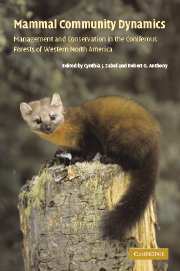 Mammal Community Dynamics
Mammal Community Dynamics Book contents
- Frontmatter
- Contents
- List of contributors
- Foreword
- Acknowledgments
- Part I Management and conservation issues for various taxa
- 1 Introduction and historical perspective
- 2 Forests and woodlands of western North America
- 3 Faunal composition and distribution of mammals in western coniferous forests
- 4 Habitat ecology and conservation of bats in western coniferous forests
- 5 Ecological relationships of terrestrial small mammals in western coniferous forests
- 6 Ecology and conservation of arboreal rodents of western coniferous forests
- 7 Small and mid-sized carnivores
- 8 Ecology, conservation, and restoration of large carnivores in western North America
- 9 Ungulates in western coniferous forests: habitat relationships, population dynamics, and ecosystem processes
- Part II Community and ecosystem relations
- Part III Conservation issues and strategies
- Index
- References
8 - Ecology, conservation, and restoration of large carnivores in western North America
Published online by Cambridge University Press: 15 December 2009
- Frontmatter
- Contents
- List of contributors
- Foreword
- Acknowledgments
- Part I Management and conservation issues for various taxa
- 1 Introduction and historical perspective
- 2 Forests and woodlands of western North America
- 3 Faunal composition and distribution of mammals in western coniferous forests
- 4 Habitat ecology and conservation of bats in western coniferous forests
- 5 Ecological relationships of terrestrial small mammals in western coniferous forests
- 6 Ecology and conservation of arboreal rodents of western coniferous forests
- 7 Small and mid-sized carnivores
- 8 Ecology, conservation, and restoration of large carnivores in western North America
- 9 Ungulates in western coniferous forests: habitat relationships, population dynamics, and ecosystem processes
- Part II Community and ecosystem relations
- Part III Conservation issues and strategies
- Index
- References
Summary
Introduction
Large carnivores operate over large spatial scales and affect and are affected by multiple ecosystem processes (e.g., predation, migration, climate, fire, etc.). Thus carnivore ecologists must deal with expansive areas and multiple scales and disciplines. For this reason, studies of top carnivores have played a significant role in fostering ecosystem approaches among managers and researchers (Minta et al. 1999). Specifically, wolves (Canis lupus), cougars (Felis concolor), and bears (Ursus spp.) have become important symbols for conservation and ecosystem management. Recent research has examined multiple large carnivores (Kunkel et al. 1999, Carroll et al. 2001) and multiple ecosystems in regional conservation networks (Soule and Terborgh 1999). Conservation perspectives resulting from such work can help build strategies to protect appreciable amounts of native biological diversity (Noss and Cooperrider 1994, Paquet and Hackman 1995, Soule and Terborgh 1999). Conservation strategies that focus on charismatic animals such as large carnivores have additional advantages because such a focus motivates organizations and the general public.
Even though large carnivores often are grouped for management and share many traits, some important differences affect their resiliency (Weaver et al. 1996). The most obvious split occurs between the obligatory predators (cougars, wolves, and jaguars (Panthera onca)) and the omnivorous facultative predators (bears). Cougars, wolves, and jaguars have higher dispersal capabilities and higher reproductive rates than bears. Wolves are social; cougars, jaguars, and bears are solitary.
- Type
- Chapter
- Information
- Mammal Community DynamicsManagement and Conservation in the Coniferous Forests of Western North America, pp. 250 - 295Publisher: Cambridge University PressPrint publication year: 2003
References
- 4
- Cited by


